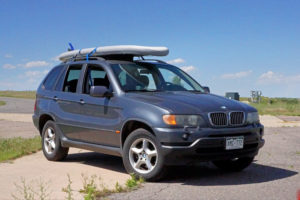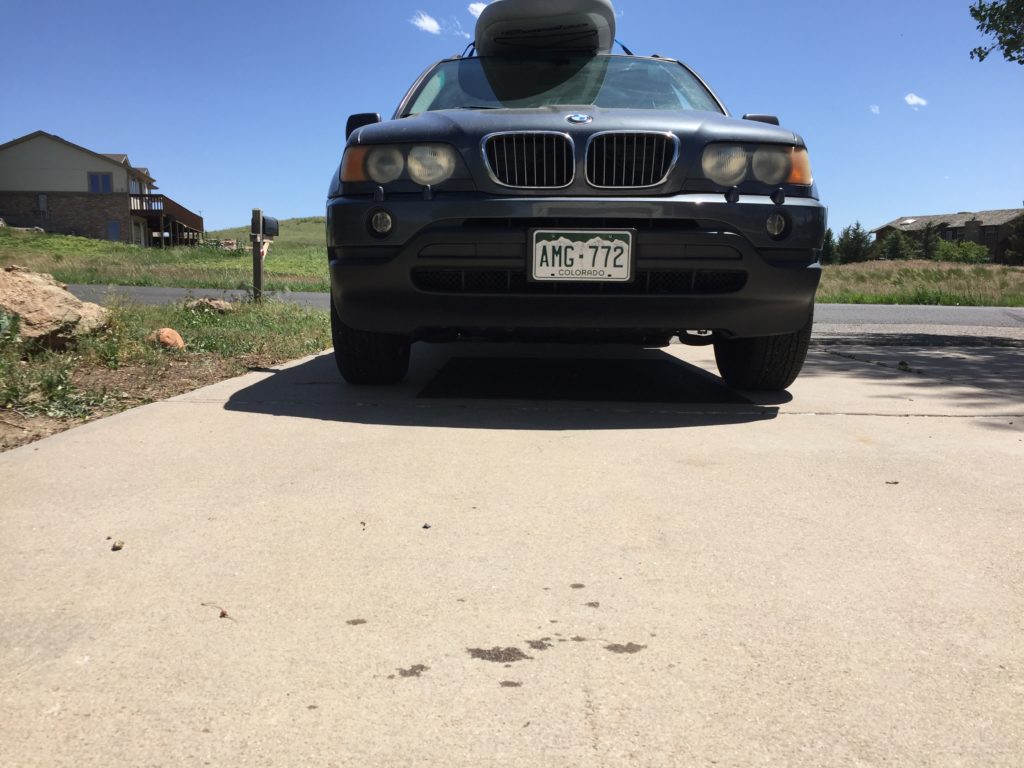There is a segment of the automotive-enthusiast community that sees beauty where the rest of the world sees junk, people who are proud of what most would be embarrassed at, and those who see value and utility where others only see a busted-up car nearing the end of its life.
We are the beater enthusiasts.
Our motivations vary. For some, it may be to spare our nicer cars from the rigors of rush-hour traffic, snow and hail, and distracted drivers; for others, it may be that we stumbled onto a car that was so cheap that it was worth its “good bones,” despite its grotesque cosmetic deformities. Yes, friends, we are lovers of beaters—and this month I’m devoting my small corner within the great halls of automotive writing to our cause with some critically important Beater Journalism.

The beaters keep allow the nice cars to stay warm, dry, and safe.
First, let’s define some criteria. What defines a beater is a sliding scale; one man’s beater might be another man’s dream car. But there are some common traits among all beaters. A beater must be cheap; this is a relative term, but for me, that number falls at around three grand, which should result in a somewhat presentable, reliable, and functional car (i.e., it turns in both directions and most doors open; operable air-conditioning is an absolute bonus). Second, it must be too far-gone to make into a nice car, because then it is just a rescue, and not a beater.
Third, it must have a mission: commuter, dog-hauler, Home Depot-runner, race-car hauler, etc.
Two BMWs of mine have fit this bill recently, but in different forms. This begs another question: Which one is the better beater—a crossover or a wagon?

Beater Number One: My wife’s 2003 X5 3.0. Yes, it’s a surfboard. Yes, we live in Colorado. [Photo: Peter Thompson]
The operative word is almost.
The X5 was acquired for an extremely good price thanks to its needing a healthy dose of deferred maintenance and a window that was stuck down in the middle of winter. After attending to a window regulator, a few wheel speed sensors, two oxygen sensors, and refreshed crankcase-ventilation plumbing, it has been virtually trouble-free in the six months that we have owned it. The only additional items since then have been a bad hood-alarm switch that would erroneously sound only during the most embarrassing times and more crankcase-ventilation plumbing that decided to hemorrhage oil on our unstained driveway. (It was only a matter of time with the number of BMWs on the property.) A clicking front CV axle sounds an ominous, but familiar, alert under full steering lock, but it’s got a few thousand miles left by my estimation.

Eew: The X5 marked its territory with oil stains on virgin driveway concrete.

The 2001 525i Touring was partially traded for an old hang-glider.
The E39 wagon is a 2001 BMW 525i Touring that I purchased from a friend in partial trade for an old hang-glider. The odometer reads just over 160,000 miles, which is odd, because Carfax last reported it at close to 200,000 This 525iT heralded from New Jersey, then Maryland, before moving to the foothills of Colorado’s Rocky Mountains, where it sat outside for the better part of a year—hard living indeed.
It made it to my side business under its own power, but it had some severe running issues. Josh, the head mechanic, gave it a cursory inspection and casually mentioned that there was a weasel living in the engine bay. I was certain that it was a black squirrel—they live in the foothills—or maybe even a marmot, but definitely not a weasel.
We opened the hood. Sure enough, there was a weasel living under the air-intake boot; he had been in residence for quite some time, and was very angry to have been disturbed.
I didn’t know that weasels lived in Colorado, but evicting him would be the first order of business. Prodding him delicately with a broomstick only infuriated him further, but a gentle blast from the air compressor did the trick. He scampered off into a nearby field, and other than a perceivable decline in the rabbit population over the next few weeks, we never heard from him again.

The 525iT’s standard Gray leather was in good nick for a beater.

The stereo consisted of a modern Alpine head unit perched in a massive space in the dashboard.
After we repaired multiple unmetered air leaks, chewed-through wiring—do weasels crave copper?!—and a cracked rear subframe, and performed a full round of preventative M54 engine maintenance, the 525iT turned out to be a very nice beater. It’s outfitted with two-piece seventeen-inch BBS Style 5 wheels, a self-leveling sport suspension that actually worked once we replaced the air bags, and a host of other options. The hood, hatch lid, and wheel roundel emblems were naked silver, thanks to losing most of their colors; the effect actually looks quite good against the wagon’s Anthracite paint. The standard gray leather interior wore the stains of use, but cleaned up nicely. The cup-holders were broken, but they are useless in the E39 anyway. The wood trim had more cracks than lake ice in April, and in place of the original stereo was a modern unit literally sitting in a vast opening; behind it, you could see where a previous stereo installer had cut a hold in the blower-motor cover to make it fit, which does improve airflow—somewhat. The trifecta of brake, ABS, and DSC lights would undoubtedly be illuminated if some previous owner hadn’t fixed the issue… by removing the bulbs.
But once the running issues were sorted, we liked the 525iT so much that it became the shop parts-runner .

Which $3,000 BMW beater is better? [Photo: Peter Thompson}
The trade-off is slightly worse gas mileage, a recorded 21 miles per gallon in mixed city/highway driving, while the 525iT records a solid 25 miles per gallon.
My wife appreciates the X5’s tall seating position and visibility, while I appreciate the 525iT’s sporting handling, which has been proven time and again on my circuitous country-road parts-run route. Moving off the pavement to grass and dirt (because that’s about the toughest four-wheelin’ most X5s will see), the X5 has the advantage in ground clearance and hill climbing thanks to its all-wheel drive, but the 525iT clawed up the same steep grade even with copious wheel spin.

The X5 climbs the grassy knoll with ease. [Photo: Peter Thompson]

[Photo: Peter Thompson]

[Photo: Peter Thompson]

[Photo: Peter Thompson]

The 525i Touring made it up the slope, but not without lots of rock-tossing wheelspin. [Photo: Peter Thompson]

[Photo: Peter Thompson]

[Photo: Peter Thompson]

[Photo: Peter Thompson]
We loaded five adults and two dogs into each BMW, opting to put the tallest person behind the driver’s seat and the largest person in the center rear seat. Where the 525iT was tolerable, the X5 was actually comfortable for the humans. The dogs, on the other hand, appreciated the longer hatch area of the 525iT, but not as much as they appreciated the notion that they might be going go for a car ride!
With the rear seats folded forward, the 525iT edged out the X5 in length, but not height. I used a 55-gallon rain barrel as a test object; both BMWs could easily fit three barrels with room to spare. Up top, both had factory roof rails installed, and enough roof surface area to easily strap a paddle board down on riser pads, although the X5 required climbing up onto the rear doorsills to reach. The X5 makes up for this with a tailgate, which makes concert and sporting-event tailgating easier than “hatchbacking” would be in the 525i.

The 525iT’s broken cup-holders, which I wouldn’t trust even when new. [Photo: Peter Thompson]

The X5 wins the cup-holder contest. [Photo: Peter Thompson]

Three rain barrels can fit in the back of either BMW with room to spare. [Photo: Peter Thompson]

Five adults are happy in the X5, less happy in the 525iT. [Photo: Peter Thompson]

[Photo: Peter Thompson]

The dogs prefer the extra hatch room of the 525iT. [Photo: Peter Thompson]
The 525iT rewards its driver in ways that a crossover simply cannot. Even with a massive crack in the front bumper cover, it looks much better than the bulky X5. Behind the wheel, it’s also the beater I would prefer for road trips and spirited driving. It makes a fantastic parts-runner for the shop, and will likely be driven more in the summer thanks to ice-cold air-conditioning.
That said, if I’m honest, I’d be happy with either beater. For three grand, both cars are fantastic BMWs that I am proud to have under my stewardship. I will care for and cherish them just like the nicer cars in my stable—just with a little more abuse and a little less guilt—Alex McCulloch





















